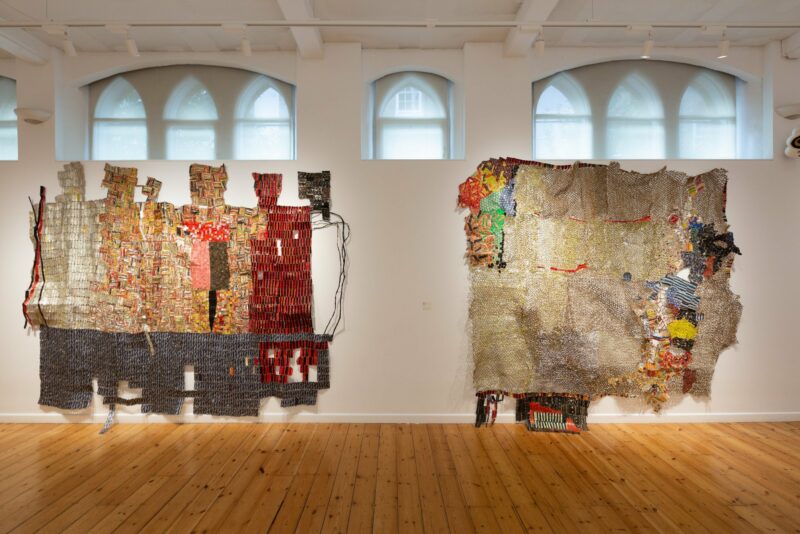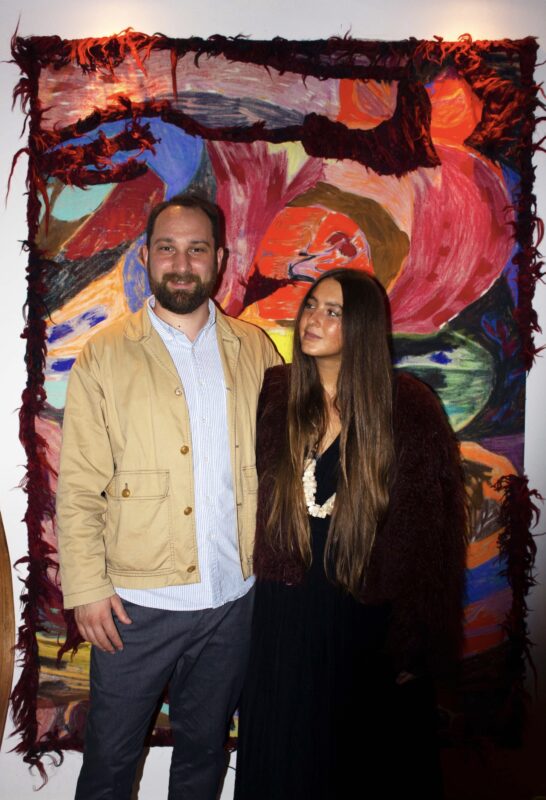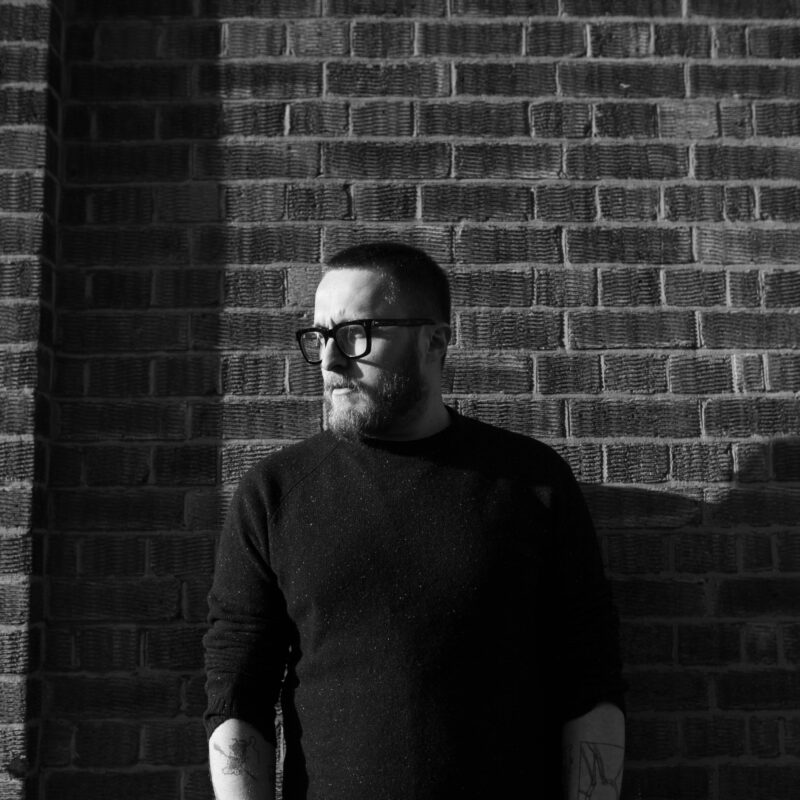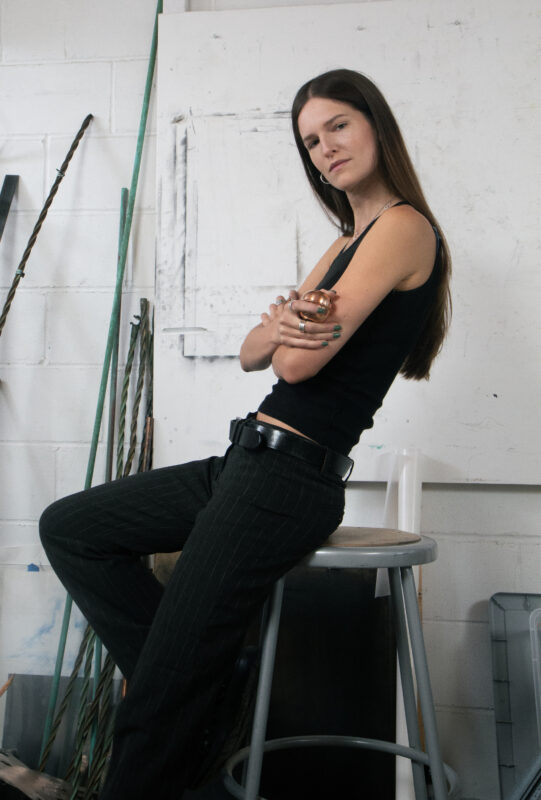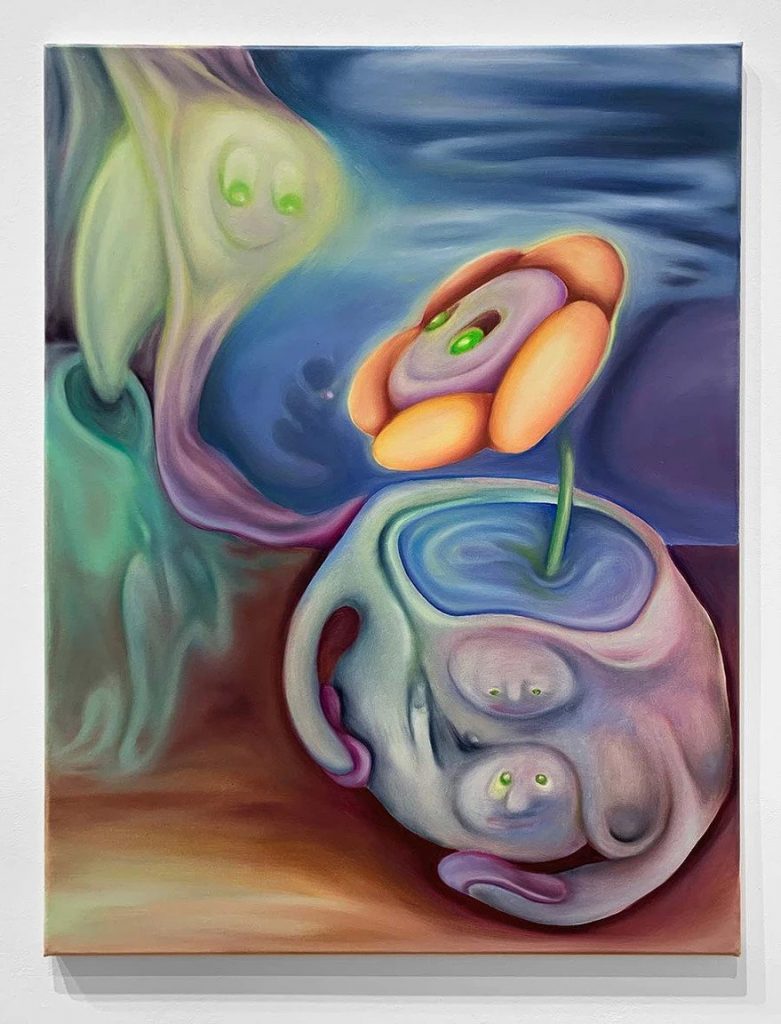
Xiuching Tsay Love Too Soon, 2019
Thailand born, London based artist Xiuching Tsay recently sat down with art historian, writer and curator Hector Campbell to discuss her undergraduate study of Fashion Illustration, the evolution of her painting practice, her fascination with water and her current exhibition A Haze in Their Gaze at Daniel Benjamin Gallery in London, which runs until December 14th.
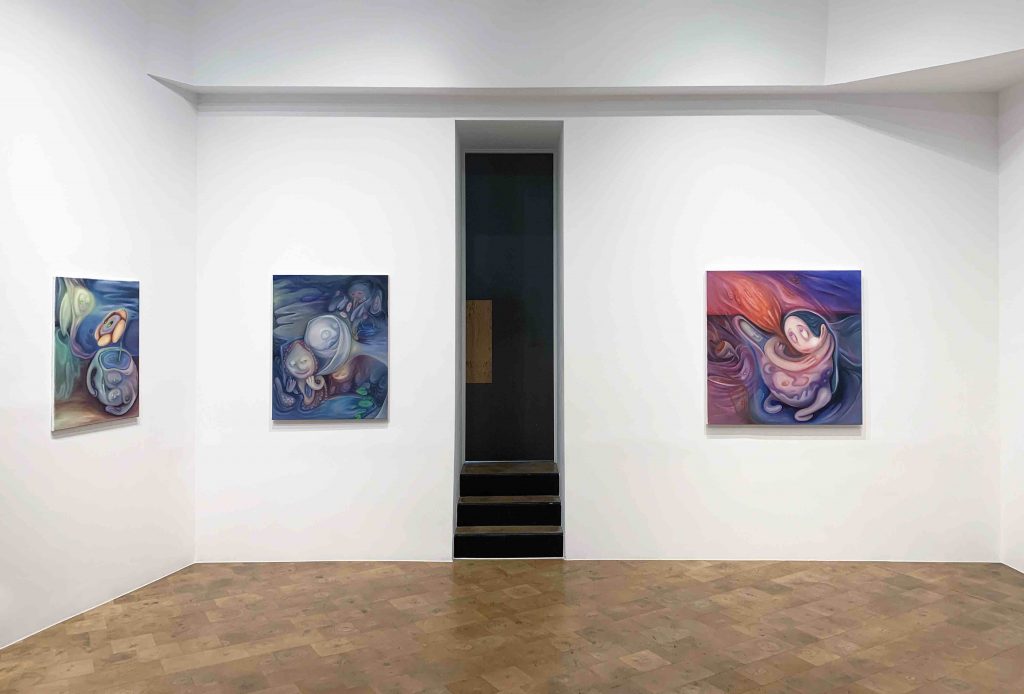
Xiuching-Tsay-Josh-Rowell-Paula-Morison-Daniel-Benjamin-Gallery-Installation-shots
Hector Campbell: Prior to studying for an MA in Painting at the Royal College of Art, you completed your BA in Fashion Illustration at the London College of Fashion, during which time your artwork often rejected the traditional model of elegant, feminine drawings in favour of more abstracted, distorted caricatures exposing the sexual innuendos prevalent in fashion advertising. What led you to study Fashion Illustration as opposed to a conventional fine art course? And does your background in Fashion Illustration still influence your current practice?
Xiuching Tsay: When I was younger, I wasn’t sure about my path because I had so many interests. I went for whatever I was into at that time, I was the kind of person who only focused on the present and not the future. I became interested in fashion because I enjoy seeing people who have a cool fashion sense, and lots of my best friends are interested in fashion too. However, the thing I could do best was drawing or painting, so I chose a fashion illustration course because at least I could draw! I think art came naturally to me, even when I was in a science class I was always drawing doodles at the back of the classroom. I learnt a lot from fashion illustration course. We had life drawing classes twice a week and mostly the models were female. This might have been an influence on my current practice, there are female bodies appear in my paintings, although, as you can see, they are expressed in distorted forms.
However, I was able to notice my real passion for conventional fine art when I was in the final year of BA degree. We had to do our final year project, which could be anything as long as it has a fashion context. I think that everything you explore in the artistic fields can be linked together. At the time I was into aliens, They Live and videos of innuendos in cartoons and advertising, as well as Maurice Merleau Ponty’s books (there are lots of his quotes that sparked me). My final project was inspired by all of these sources, I submitted it in painting form and also made installations and sculptures to accompany the paintings.
H.C: Over the course of your aforementioned MA in Painting at the RCA, you moved away from figuration almost completely, alongside adopting a vibrant, neon colour palette and exploring more three-dimensional forms of creating, presenting for your final degree show paintings merging a variety of materials, as well as sculpture. How did your artwork develop over the course of your post-graduate studies? And how did it compare to your undergraduate course?
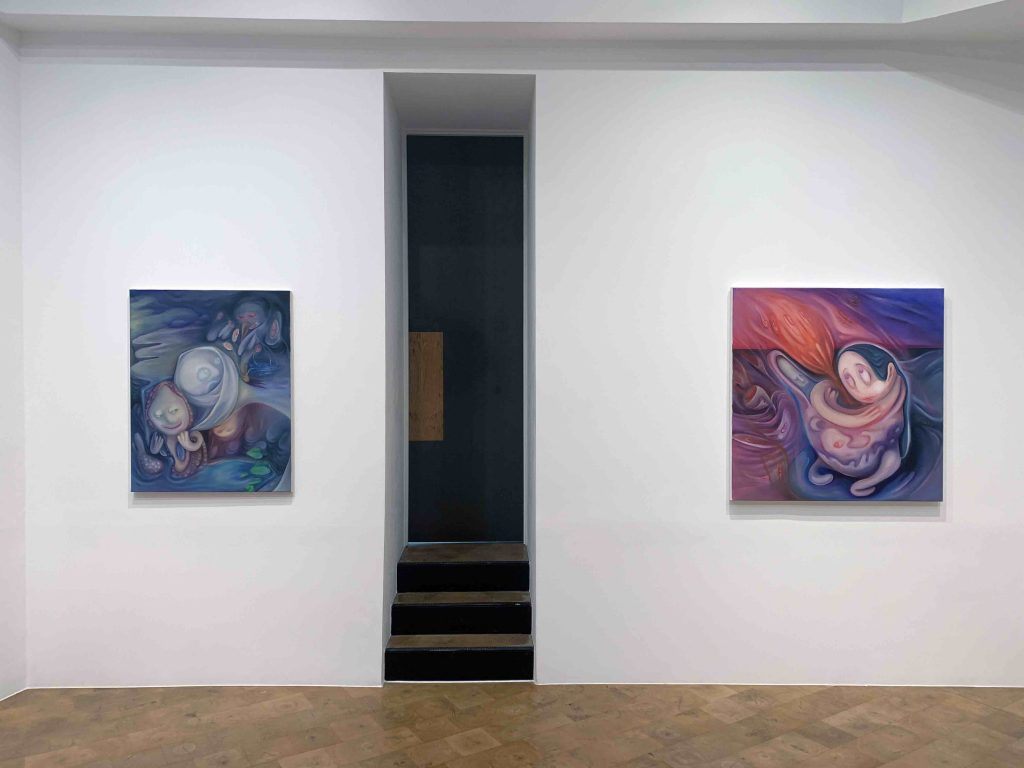
X.T: I guess my practice keeps changing because my interests have never been certain, I always seek for new things. In the first term of my first year at RCA, I was so obsessed with the details in paintings, I became lost in the finest of lines. Then, I managed to overcome my fears of not having a perfect painting after my live painting performance at Ne’Na in Chiang Mai, Thailand. The subsequent work was a big mess, I didn’t even keep it, but that doesn’t mean I dislike it. In fact, it’s one of the best works I’ve made as it taught me that the joy in the process of making is the most important. During the performance, I didn’t feel like I was painting but rather that I was having an adventure at sea. Those twenty minutes were a beautiful moment for me, that I still remember.
After that, my practice changed, as well as my attitude. I paint a lot faster, and the more I paint the more I am losing the desire to form clear figures. However, I cannot say that my paintings are completely abstraction. They remain figurative but are more obscure than the previous year’s paintings and especially those that I made during my undergraduate course. Now I like my paintings to give off a sense of obscure illusion, that unfolds infinite imagination and gives people a liberation to characterise those figures by themselves.
The only thing that has not changed so much is my colour palette. To be honest, I don’t really start with a plan for what colours to use. I normally squeeze random colours on the palette board, then dip into a bright colour and swing a brush in a circle shape that replicates the sun or the moon. The other colours come after that, by following my instinct. I always lay the sun or the moon on a canvas first as if it is my guide for the painting journey. Other elements then indicate a humankind who depend on the sun and the moon.
Talking about humankind, I am also interested in ancient crafts including totemism and mummifications. In some recent work, I’ve experimented with organic mediums and earthy material such as hessian jute and found objects. For ‘A salad bowl is good for you’ (2019) I adopted the concept of mummification by mummifying an aubergine and some grapes. I thought it would get rotten but surprisingly it is still in good condition!
H.C: Much of your artwork, even those early fashion drawings created during your BA, incorporate and explore ideas surrounding water and liquids, and much has been written about how your practice employs the concept of water as a way to traverse more spiritual and ethereal realms. Could you speak a little to your interest in water, and to where this fascination with fluids began?
X.T: My hometown, Chonburi, is located near a gulf of Thailand so I always have been near water. Hanging out at beaches was my regular activity. But, when I moved to London, there is less chance for me to experience a seascape. I now live pretty much in a completely urban lifestyle, with advertisements, consumption, logos and social contexts everywhere. Sometimes I can feel constrained in such as society. So, at least 3 days a week, I go to sit by the Thames to have lunch or just contemplate the water, sometimes watching the sun setting at the same time.
Water gives me a strange peace of mind. Just by sitting near the river, I can pay more attention to the lives of others and I can feel the effects in beings such as birds, flowers, trees and humans. The behaviours of birds, for example, are affected by the mood of the river. When the water is at high tide, the birds seem to be more berserk than usual. I find this quite magical; water is uncontrollable, something beyond a human’s reach, and yet it affects every being. I wanted to adopt that power of water in my painting, in order to wash off all the attached meanings of the life that I portray in a painting. When water melts those figures on a canvas, I can see different possibilities in my paintings.
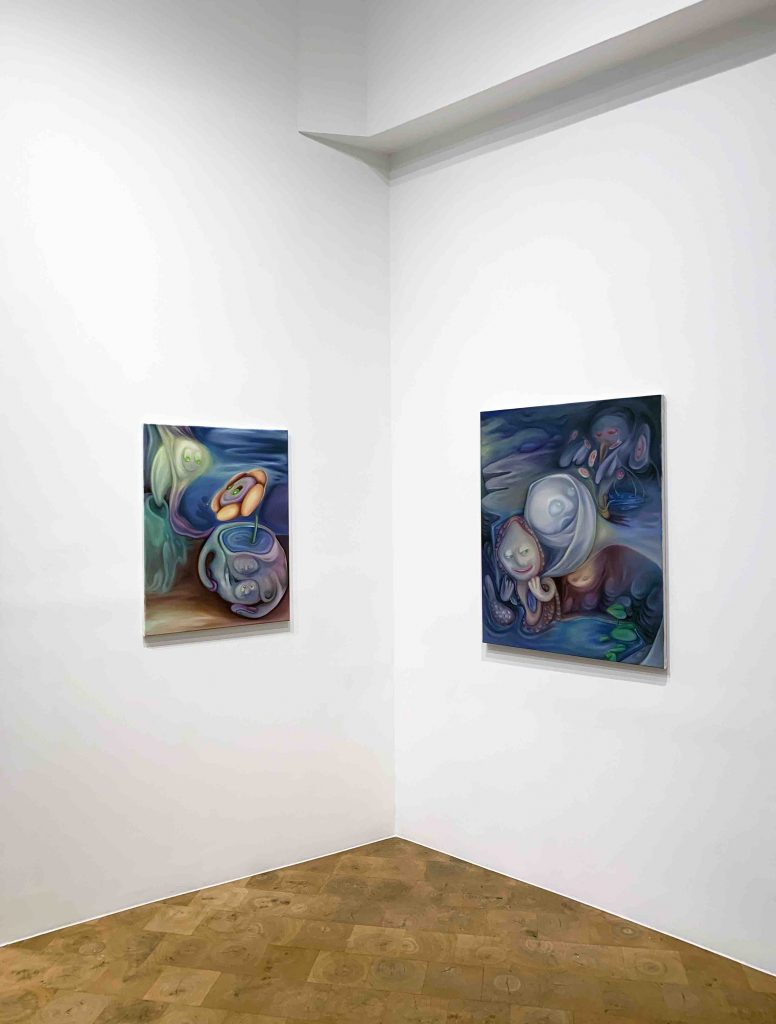
H.C: In addition to this interest in how the concept of water can unlock the transcendent level of comprehension, you have also spoken of your attraction to hallucination and the exploration of inner, parallel worlds as a way to reconfigure your understanding and appreciation of the physical and the intimate. How do these concerns implement themself within your artistic practice, and what effect do these more conceptual notions have on your output?
X.T: I love contemplating water, I would even spend a long time in a bathtub thinking about something that happened in life while watching the water ripple at the same time. The swirl patterns of water give me a lot of imaginations, the recurring images of reality are corrupted by an unknown power. I always find it so hard to get out of the bathtub, as if the freshness of the water lures my mind into a strange world, the world of silence. But, once I get out, I couldn’t recognise exactly what was appearing in my imagination. It was just a singular moment in which I could access a realm of inner experience where the recurring images that conjured up in my consciousness are no longer just an image, but a three-dimensional world that carries both erratic and vital elements. Water is the medium that allows me to reconnect with those elements in the images.
This is the same way that I approach a painting. Before I start, I usually have a vague image that stuck in my brain. It has at least a shape at first but one that keeps repeating itself with a limited meaning until I lose an acknowledgment of its meaning, until it becomes merely a shape that call upon my curiosity. By accessing the inner world of those intimate images, it melts their original form into the most ambiguous form, introducing to me their many characters and behaviours. In the process of painting, I usually randomly swing my brush following water movements such as waves and spirals, and with each movement, I can tell the mood of the image. I then keep brushing until I can identify its character on the canvas, the next elements subsequently appear naturally until the painting eventually develops a narrative.
H.C: For your debut UK solo exhibition, ‘A Haze in their Gaze’ at Daniel Benjamin Gallery, you present a new body of paintings that feels like a further evolution from the works on display in your degree show, with these new artworks utilising the traditional medium of oil on canvas and a more muted, organic colour scheme. Could you tell us more about these new works, their underlying ideas and influences?
X.T: ‘A Haze in Their Gaze’ came from the realization of my obsession for a monstrous gaze that appears in a painting. As I mentioned earlier, I want to develop my relationship with those imagery beings, I want to be a part of their inner worlds. And a gaze is an important method for communication between a painter and a painting, as the famous quote says “The eyes are a window to the heart”.
Two paintings that I made during my second year in RCA are in this show because I find they communicate in a similar way, through their monstrous gaze. The rest are pretty recent, and they have a darker tone because not so long ago I finally overcame my fear of using dark colours. This progression has really influenced my new work a lot. Before that, I’d never even bought an ivory black colour but now I now have many shades of black and other earthy tones. I have so much fun at art supply stores as I look for mediums or material that I have never tried.
However, although I have been experimenting with new mediums, traditional oil painting always remains my favourite as the texture is fluid, oily, slippery. It can improve the flow of a painting. I am also a big fan of classical oil paintings. There is something about those old master paintings that I find peaceful, powerful and mysterious at the same time. In The National Gallery, for example, I can stand there looking at my favourites for hours.
H.C: Both of your previous solo exhibitions, ‘Dead Man’s Fantasy’ at 3331 Art Chiyoda in Tokyo, Japan and ‘Discovery of the ‘I’’ at Ne’Na Contemporary Art Space in Chiang Mai, Thailand, where the result of artist residency programmes. You also recently completed a month in residence at Oli Epp’s Plop Residency in London, where I believe you created some of the paintings on display at Daniel Benjamin Gallery. What do you enjoy about undertaking artistic residencies, and how can they benefit young artists?
X.T: My practice is naturally affected by my personal experiences, my day to day surroundings. So by getting onto art residency programs I have been able to experience rare scenes and be in situations where I have never been before. Each residency gave me different experiences, all inspirational in their own way. I think being on residencies has helped me conceptualise my practice. The different work that I produced during the three residencies expressed the different aspects of how I see the world and how I Identify my existence in society.
‘Dead Man’s Fantasy’ at 3331 Arts Chiyoda was supposed to be ‘Deaf Man’s Fantasy’, a concept that came from my personal experiences during my stay in Tokyo. It was a strange, yet super inspirational experience that encouraged me to write diaries every day. I felt like I was in an alienated environment where I became a deaf person, as communication was difficult because many locals don’t speak English. I was never sure if I understood them correctly, we had to interpret and understand each other through body language and the imagination that involves. Therefore, that experiences influenced me to produce work exploring how bodies play an important part in communicating.
With ‘Discovery of the ‘I’’ at Ne’Na, while the locals spoke the same language as me (Thai), the residency was located in a quiet, mountainous area, giving me peaceful time to appreciate nature. Nature is ubiquitous, a bigger unit than a human. It brought me to question my existence in the world and what is my definition of ‘I’. In the middle of nature, ‘I’ became something small, almost nothing. This notion really influenced the change of my belief in art, I learnt that whatever I made in my paintings are not my identification, they are just a history of ‘I’, once identified by other things.
Plop Residency is located in Central London and, despite living in London for many years, I found this could be an opportunity for me to explore another side of London life. It was a great experience as I met so many interesting people, including Oli Epp the other artists, and what inspired me and the new body of work was the memorable moments that came from hanging out with them. I think the most enlightening aspect of joining a residency is the chance to connect with new people. To meet new people is to meet another side of yourself. And when you realise the other side of yourself then you can see the growth in your work.
H.C: Finally, your paintings ‘Drunken Gravity’ and ‘As his burden’ were selected for this years Bloomberg New Contemporaries exhibition, the prestigious annual survey of recent UK graduating artists, which travels from Leeds Art Gallery to South London Gallery on the 6th of December. What does it mean to be included in an exhibition such as New Contemporaries, and, from visiting the exhibition in Leeds, do you recognise any themes or commonalities emerging amongst your graduating class?
X.T: I was quite surprised when I found out the result! But since the exhibition tour in Leeds, I felt like there are more people who recognise my work and some people who are interested in understanding the context behind my practice. Also, this exhibition gives me an opportunity to meet many new people who are working in different art fields such as curators or artists such as Bens Rivers, Sonia Boyce and Rana Begum.
More importantly, I can get to know many interesting artists of the same generation. I think it is a good chance to know them when they are still young and get to see their progression in their artistic career. There are many artworks that I recognised in Leeds, maybe because I have seen them in degree shows in London or on Instagram. The most surprising thing is that my friend and ex studio mate Yulia Iosilzon is in the same exhibition. I had seen her work at the studio where we were sharing, but It is a different, more interesting, feeling seeing it in the exhibition space.
